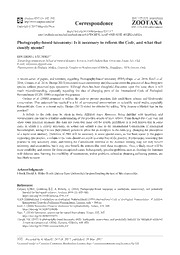
Photography-based taxonomy: Is it necessary to reform the Code, and what that exactly means? PDF
Preview Photography-based taxonomy: Is it necessary to reform the Code, and what that exactly means?
Zootaxa 4247 (3): 332–332 ISSN 1175-5326 (print edition) ZOOTAXA http://www.mapress.com/j/zt/ Correspondence Copyright © 2017 Magnolia Press ISSN 1175-5334 (online edition) https://doi.org/10.11646/zootaxa.4247.3.7 http://zoobank.org/urn:lsid:zoobank.org:pub:D7DCBF5E-AA47-450D-9D5E-4052FEAA452A Photography-based taxonomy: Is it necessary to reform the Code, and what that exactly means? EDUARDO I. FAÚNDEZ1,2 1Entomology Department, School of Natural Resource Sciences, North Dakota State University, Fargo, ND, USA. E-mail: [email protected] 2Departamento de Zoología Médica, Centro de Estudios en Biodiversidad (CEBCh), Magallanes, 1979, Osorno, Chile A recent series of papers, and rebuttals, regarding Photography-based taxonomy (PBT) (Pape et al. 2016, Krell et al. 2016, Ceríaco et al. 2016, Thorpe 2017) has raised much controversy and discussion about the practice of describing new species without preserved type specimens. Although there has been thoughtful discussion upon this issue, there is still much misunderstanding, especially regarding the idea of changing parts of the International Code of Zoological Nomenclature (ICZN 1999) to regulate this practice. Ceríaco et al. (2016) proposed to reform the code to prevent practices that could harm science and biodiversity conservation. That statement has resulted in a lot of controversial conversations on scientific social media, especially ResearchGate. Even in a recent reply, Thorpe (2017) ended his rebuttal by asking ¨Why impose a blanket ban on the practice?¨ A reform to the code may be taken in many different ways. However, being familiar with taxonomy and nomenclature can lead to a further understanding of the possible results of such reform. Even though the Code may not allow some practices anymore, this does not mean that these will be strictly prohibited. It is well known that in some cases in which it is strictly necessary, an author can submit a case to the International Commission of Zoological Nomenclature, asking it to use their plenary powers to allow for an exception to the rules (e.g. changing the precedence of a name over another). Therefore, if PBT will be necessary in some special cases, as has been stated in the papers supporting this practice, a reform to the code should not result in a total ban of the practice. Furthermore, restricting this practice to only necessary cases, and having the Commission involved in the decision making, may not only benefit taxonomy and taxonomists, but it may also benefit the authors that need these exceptions. Thus, a likely result will be more credibility and control for these exceptional cases. Subsequently, possible problems such as flooding the literature with dubious taxa, harming the credibility of taxonomists, and/or problems related to obtaining collecting permits, are less likely to occur. Acknowledgments I thank David A. Rider (North Dakota State University) for proofreading the text of this manuscript. References Ceríaco, L.M.P., Gutiérrez, E.E. & Dubois, A. (2016) Photography-based taxonomy is inadequate, unnecessary, and potentially harmful for biological sciences. Zootaxa, 4196 (3), 435–445. https://doi.org/10.11646/zootaxa.4196.3.9 ICZN [International Commission on Zoological Nomenclature] (1999) International Code of Zoological Nomenclature. 4th Edition. International Trust for Zoological Nomenclature, London, xxix + 306 pp. Krell, F. (2016) Taxonomy: Preserve specimens for reproducibility. Nature, 539, 168. https://doi.org/10.1038/539168b Pape, T. (2016) Taxonomy: species can be named from photos. Nature, 537, 307. https://doi.org/10.1038/537307b Thorpe, S.E. (2017) Is photography-based taxonomy really inadequate, unnecessary, and potentially harmful for biological sciences? A reply to Ceríaco et al. (2016). Zootaxa, 4226 (3), 449–450. https://doi.org/10.11646/zootaxa.4226.3.9 332 Accepted by A. Minelli: 24 Feb. 2017; published: 28 Mar. 2017 Licensed under a Creative Commons Attribution License http://creativecommons.org/licenses/by/3.0
